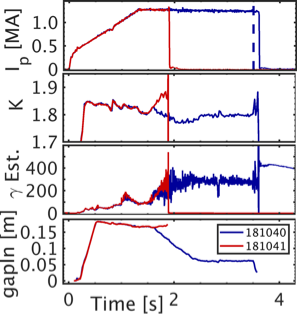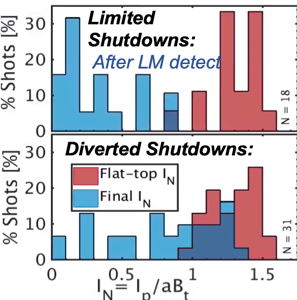Speaker
Description
DIII-D and EAST are developing and qualifying a comprehensive disruption control toolset to help ensure ITER success. The 2019-2020 DIII-D program began a focused effort, called the “Disruption Free Protocol” (DFP), to qualify disruption control techniques including emergency shutdown and continuous regulation of proximity to stability boundaries.
A new control architecture has been developed for continually regulating proximity to multiple stability limits simultaneously. The proximity controller has been applied in experiment for vertical disruption (VDE) prevention on DIII-D. The open-loop VDE growth-rate ($\gamma$) was kept to safe levels (300-400/s) for > 2s by continuously modifying the plasma elongation ($\kappa$) and gap between the plasma and inner-wall. The growth-rate was estimated using a real-time, neural-network-based surrogate model with uncertainty estimation. Discharges were pre-programmed to increase elongation to induce VDEs. By applying the proximity controller, VDEs were robustly prevented until the controller was intentionally disabled (Fig. 1). The proximity control architecture is being ported to EAST, where a GPU-based, real-time VDE $\gamma$ calculation has been developed (1). Ongoing proximity controller development is integrating active MHD spectroscopy, machine learning (2), and tearing mode stability metrics (3).


Locked modes also pose a serious challenge for disruption prevention. Inducing a fast (2-3 MA/s on DIII-D), controlled shutdown is a common method for preventing disruptions after large tearing and locked modes. Its effectiveness is being quantified, making extensive use of DIII-D’s asynchronous Off Normal Fault Response controller (4). As the magnetic energy is proportional to $I_p^2$, the final $I_p$ reached before current quench is used as the metric for emergency shutdown success. Rapidly transitioning to a limited topology in shutdown can dramatically reduce the final normalized current ($I_N$) reached before terminating, with as much as 50% of shots below the ITER 15 MA scenario limit of $I_N$ < 0.3 (Fig. 2). In contrast, maintaining a diverted topology resulted in less than 20% reaching safe final currents, and the majority disrupting above $I_N$ > 0.8. Fast (up to 0.7 MA/s), emergency shutdowns have been developed on EAST for both limited and diverted topologies, and point to the potential of real-time feed-forward control for super-conducting devices. ITER tolerance to a limited topology is an open question, and likely depends on H-L back-transition timing.
Disruptions are a critical issue for fusion energy, and ITER requires control solutions spanning the full range of control regimes: from early prevention with proximity-to-instability control to emergency responses like rapid shutdowns.
This work was supported in part by the US Department of Energy under DE-FC02-04ER54698 and DE-SC0010685.
(1) N.N. Bao et al 2020 IEEE Trans. On Plasma Sci.
(2) C. Rea et al 2019 Nucl. Fusion
(3) F. Turco et al 2018 Nucl. Fusion
(4) N.W. Eidietis et al 2018 Nucl. Fusion
| Member State or International Organization | United States of America |
|---|---|
| Affiliation | General Atomics |
